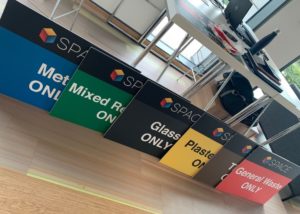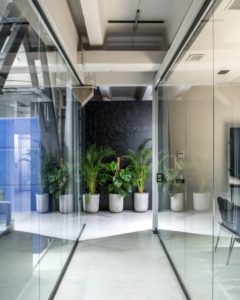With 4/5 of Scotland’s carbon footprint coming from waste, it’s important to recognise the value in reusing, recycling, or repurposing existing materials.
Last week, I had the privilege of speaking at Circular North-east’s event: Sharing Best Practice – Construction and Renovation. It was a pleasure to be part of the discussion, which recognises companies’ contributions to the Circular Economy.
It’s a challenge to be sure, but one we’re committed to facing. Wherever we can, with refurbishment projects we follow a methodical process to make it as economically and environmentally responsible as possible. Our first step is to conduct a ‘destructive survey’. The name sounds terrible but that’s where the association stops. The purpose of the survey is to assess quantity, suitability, and scope for reuse of products and materials such as flooring, partitions, ceilings, light fittings, furniture, etc.
Our design and construction teams work together to explore opportunities and implications for reuse of products and materials. This is key, because a successful circular economy project relies on the design and construction teams being aware of the project objectives and working collaboratively towards the same end goal.
What we’re able to reuse at the existing site is carefully dismantled and set aside. Other materials with potential for reuse may be stored or used on another live project. When reuse is not an option, waste is segregated so that the potential for recycling is maximised. Our main objective in all this is to avoid landfill whenever possible.
Furniture products with a reuse value that aren’t used at the existing site are made available or promoted through Recycle Scotland, SPACE’s champion branch for the Circular Economy. Recycle Scotland is the forerunner of our recycling activities, working to keep redundant furniture and effects from going to landfill. I’m proud to say this part of our business has recycled over 5,000 tonnes of office furniture.
We recently completed the refurbishment of a three-story office building where we put the circular economy ethos into practice. Here’s some examples of what we were able to do:
- Reuse existing doors and frames
- Deconstruct glass partitions and frames and reinstall according to new design
- Uplift, clean, and relay existing carpets
- Replace cut and worn carpet tiles, sending old tiles back to the manufacturer for recycling
- Re-engineer office furniture to fit new specifications (through Recycle Scotland)
- Strip and segregate remaining materials and dispose of in appropriate skips for recycling
We keep an eye on all our projects with the hope we can reuse or repurpose as much as possible. There are of course some challenges which are often site specific, but with proper planning for the outset it is possible to adopt circular practices.
Scotland has the opportunity to be a global leader in sustainable business practices. The circular economy is about so much more than just reducing waste, it’s about inspiring new opportunities and innovation in business and collaboration. To learn more about Circular North-east’s commitment to helping construction companies achieve success in the Circular Economy, click here.



